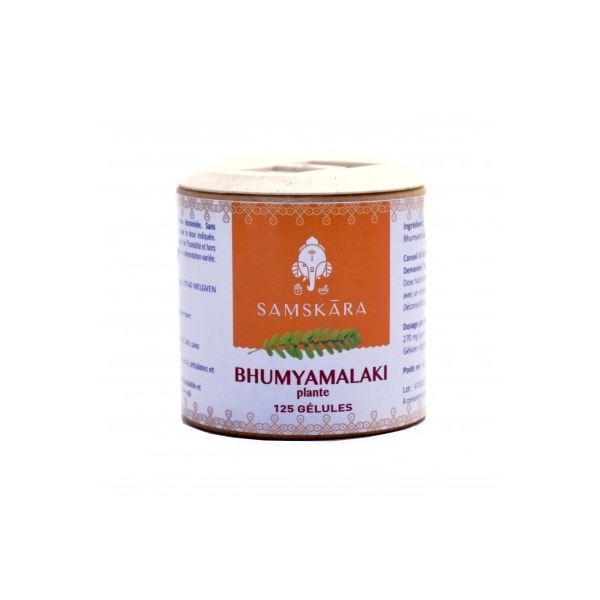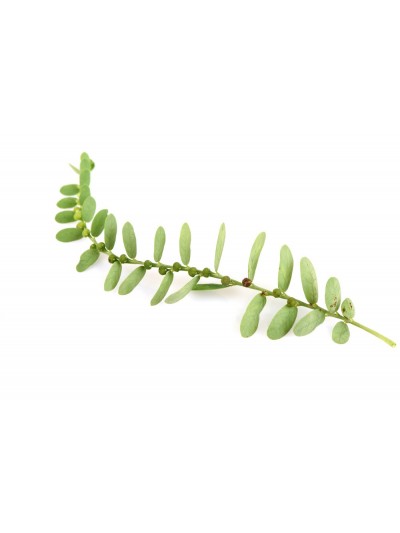BHUMYAMALAKI - 125 Gélules Ayurvédique
Indications traditionnelles:
Rasa : amer, astringent, sucré
Gunas : sec, léger
Virya : rafraichissant
Vipaka : piquant
Doshas : PK- V+
Bhumyamalaki est indiqué en cas d’insuffisance hépatique et problèmes digestifs (vomissements, acidité, perte d’appétit…), la fièvre, la tuberculose 1. Il est bénéfique contre les maladies urinaires (mutra roga) et le diabète (prameha) 2 et fait partie des plantes kasahara (apaise la toux et les refroidissements) et shwasahara (soulage l’asthme et les difficultés respiratoires) 3.
1 Ashtanga Hridayam
2 The Ayurvedic Pharmacopoeia of India
3 Charaka Samhita
Recherches scientifiques:
FOIE Hépatoprotecteur 1 qui rétablit les fonctions hépatiques altérées 2 et régénère les lésions des cellules du foie provoquées par une intoxication 3 d’origine médicamenteuse 4, alcoolique 5 ou virale. Effet significatif dans l’hépatite B chronique : inhibe la réplication du virus et rétablit le fonctionnement du foie 6.
REINS Interfère dans les étapes du processus de formation et d’élimination des calculs rénaux 7.
CANCER Puissante activité anticarcinogène contre le développement de différents types de tumeurs 8 et métastases 9 : foie 10, peau 11, poumons 12, sein 13, prostate 14. Effet synergique avec les traitements classiques 1 : radioprotecteur 15, augmente l’effet du cisplatine 16 et atténue les effets secondaires de la cyclophosphamide, notamment la cystite hémorragique 17. Effet préventif contre le cancer de la peau 18.
ETAT GENERAL Antioxydant 19 et anti-bactérien 20 à forte activité antivirale 21. Ralentit le développement du VIH 22. Soulage l’inflammation 23, la douleur 24 et l’allodynie 25. En inhibant l’activité de l’enzyme 5-alpha-réductase, réduit la conversion de la testostérone en DHT, favorisant la pousse des cheveux dans l’alopécie androgénétique 26.
SPHERE DIGESTIVE Protège la sphère gastro-intestinale (ulcères) 27. Améliore l’ensemble des symptômes de la gastro-entérite (consistance et fréquence des selles, vomissements, déshydratation, fièvre, crampes abdominales) et convient pour les enfants 28.
Conseils d'utilisation:
- Gélules : 1 à 2 gélules 3 fois par jour avec un verre d'eau (gélules en gélatine dosées à 270 mg, soit 1620 mg pour 6 gélules).
Déconseillé aux femmes enceintes.
Composition:
100 % poudre de plante de Bhumyamalaki (Phyllanthus niruri). Sans excipient ni conservateur.
Complément alimentaire 100% poudre de plante. Conserver à l’abri de la lumière, de la chaleur, de de l'humidité et hors de portée des enfants. Ne peut remplacer une alimentation variée.
[1] Rajagopalan Et Al.. “Effect Of Phyllanthus Niruri On Alcohol And Polyunsaturated Fatty Acid Induced Oxidative Stress In Liver. » Int J Pharm Pharm Sci, Vol 2, Suppl 4, 5862
[2] Makoshi et al. «Hepatoprotective effect of Phyllanthus niruri aqueous extract in acetaminophen sub-acutec exposure rabbits.» JVMAH Vol. 5(1), pp. 8-15, January 2013
[3] Roy Et Al. “Comparative Study Of The Hepatoprotective Efficacy Of A Few Marketed Polyherbal Products.” Pharmacologyonline 1: 629-647 (2009)
[4] M Chatterjee And Parames C. Sil “Protective Role Of Phyllanthus Niruri Against Nimesulide Induced Hepatic Damage. » Ind J Of Clinic Biochem, 2007 / 22 (1) 109-116
[5] P. Chattopadhyay, S.S. Agrawal and A. Garg , 2006. Liver Regenerative Effect of Phyllanthus amarus Linn. Against Alcohol Induced Liver Cell Injury in Partially Hepatectomised Albino Rats. International Journal of Pharmacology, 2: 426-430.
[6] Paithankar et al. “Phyllanthus Niruri : A magic Herb.” Research in Pharmacy 1(4) : 1-9, 2011
[7] ME Barros, N Schor, MA Boim “Effects of an aqueous extract from Phyllanthus niruri on calcium oxalate crystallization in vitro.” Urol Res (2003) 30:374–379
[8] Schmelzer GH et Gurib-Fakim A. (ed.), 2008 «Ressources Végétales de l'Afrique Tropicale 11(1). Plantes médicinales 1.» Fondation PROTA. Wageningen, Pays-Bas / Backhuys Publishers Leiden Pays-Bas, CTA Wageningen Pays-Bas, 869 pp.
[9] Lee SH, Jaganath IB, Wang SM, Sekaran SD (2011) Antimetastatic Effects of Phyllanthus on Human Lung (A549) and Breast (MCF-7) Cancer Cell Lines. PLoS ONE 6(6): e20994. doi:10.1371/journal.pone.0020994
[10] Sripathi M. Sureban et al. « Therapeutic Effects of Phyllanthus Species: Induction of TNF-α-mediated Apoptosis in HepG2 Hepatocellular Carcinoma Cells. » Am. J. Pharm. & Toxicol., 1 (4): 65-71, 2006
[11] Tang Y-Q, Jaganath IB, Sekaran SD (2010) “Phyllanthus spp. Induces Selective Growth Inhibition of PC-3 and MeWo Human Cancer Cells through Modulation of Cell Cycle and Induction of Apoptosis.” PLoS ONE 5(9): e12644. doi:10.1371/journal.pone.0012644
[12] N. Padmapriya and T.V. Poonguzhali “Evaluation Of Anticancer Activity Of Flavonoid Isolated From The Acetone Extract Of The Aerial Parts Of Phyllanthus Niruri Against Human Lung Cancer Cell Line (A549).” Int J Pharm Bio Sci 2015 July; 6(3): (P) 296 - 304
[13] Sudhakaran Et Al. “A Comparative Evaluation Of Anticancer Activities Of Flavonoids Isolated From Mimosa Pudica, Aloe Vera And Phyllanthus Niruri Against Human Breast Carcinoma Cell Line (Mcf-7) Using Mtt Assay.” Int J Pharm Pharm Sci, Vol 6, Issue 2, 319-322
[14] Tang Y-Q et al. “Phyllanthus Suppresses Prostate Cancer Cell, PC-3, Proliferation and Induces Apoptosis through Multiple Signalling Pathways (MAPKs, PI3K/Akt, NFxB, and Hypoxia).” EBCAM Vol 2013, Article ID 609581, 13 pp.
[15] Thakur et al. « Radiation Dose Response And Dose Modification Factor Of Phyllanthus Niruri On Mice: Standardization Of Radioprotector Effect.” WJPR Vol 4, Issue 09, 2015.
[16] Araújo Júnior RF et al . “Growth inhibitory effects of Phyllanthus niruri extracts in combination with cisplatin on cancer cell lines.” World J Gastroenterol 2012 August 21; 18(31): 4162-4168
[17] Vinícios T. Boeira et al. “Effects of the hydroalcoholic extract of Phyllanthus niruri and its isolated compounds on cyclophosphamide-induced hemorrhagic cystitis in mouse. » Naunyn-Schmiedeberg's Arch Pharmacol (2011) 384:265–275
[18] Priyanka Sharma et al. “Protective Effect of Phyllanthus niruri on DMBA/Croton Oil Mediated Carcinogenic Response and Oxidative Damage in Accordance to Histopathological Studies in Skin of Mice.” JNSR ISSN Vol.1, No.4, 2011
[19] Elisângela Colpo et al. “Antioxidant effects of Phyllanthus niruri tea on healthy subjects.” Asian Pacific Journal of Tropical Medicine (2014)113-118
[20] Oseni Et Al. “Solvent Extracts Of Different Parts Of Ghanaian Phyllanthus Niruri Show Potent Growth Inhibition Against Six Human Pathogenic Bacteria In Vitro.” Int J Pharm Pharm Sci, Vol 6, Issue 7, 272-277
[21] XinMao et al. « The Genus Phyllanthus: An Ethnopharmacological, Phytochemical, and Pharmacological Review. » EBCAM Vol 2016, Article ID 7584952, 36 pages
[22] A D Naik, A R Juvekar “Effects Of Alkaloidal Extract Of Phyllanthus Niruri On Hiv Replication. » Ind J Med Sci Vol. 57 No. 9, September 2003
[23] C Okoli et al. “Extracts of Phyllanthus niruri Aerial Parts Suppress Acute and Chronic Inflammation in Murine Models.” J of Herbs Spices & Med Plants 20(3) · Feb 2014
[24] Cínthia R.C. Porto et al. “Anti-inflammatory and antinociceptive activities of Phyllanthus niruri spray-dried standardized extract.” Rev. Bras. Farmacogn. Braz. J. Pharmacogn. 23(1): Jan./Feb. 2013
[25] Angélica G. Couto Et Al. “Anti-Inflammatory, Antiallodynic Effects And Quantitative Analysis Of Gallic Acid In Spray Dried Powders From Phyllanthus Niruri Leaves, Stems, Roots And Whole Plant.” Rev. Bras. Farmacogn. Braz. J. Pharmacogn. 23(1): Jan./Feb. 2013
[26] Patel S, Sharma V, Chauhan N.S , Thakur M, Dixit V.K. “Evaluation of hair growth potential of Phyllanthus niruri.” Avicenna J Phytomed, 2015.
[27] Abdulla et al. “Gastroprotective effect of Phyllanthus niruri leaf extract against ethanol-induced gastric mucosal injury in rats.” Afr. J. Pharm. Pharmacol. Vol. 4(5), pp. 226-230, May 2010
[28] Kamatnur Nabisab et al. “PA03.02. The Effect of Bhumyamalaki (Phyllanthus Niruri) in Balatisara with Special Reference to Viral Diarrhea.” From the proceedings of Insight Ayurveda 2013, Coimbatore. 24th and 25th May 2013. Ancient Science of Life 32. Suppl 2 (2013): S71. PMC. Web. 2 May 2016.


